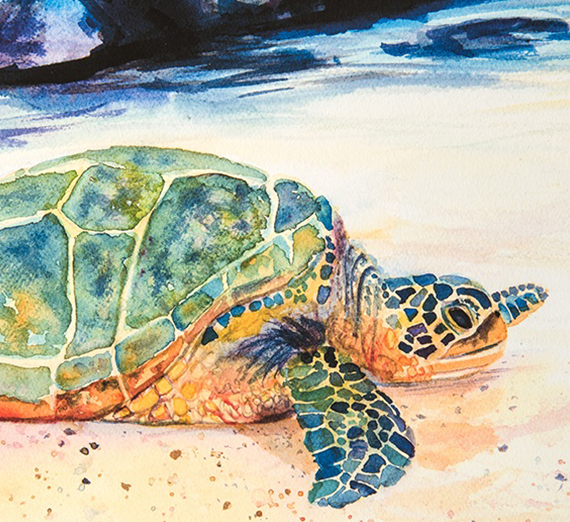Getting Honu Home: A Tale of a Green Sea Turtle

Story By Rol Herriges (’57) | Illustration by KauaiArt
During the last 50-some years, my family has experienced the love and close association of several domestic pets that rapidly became an integral part of family life. A black-and-white kitten we named Katze, a well-groomed stray miniature poodle we found on our doorstep and two Siberian huskies.
But the latest “pet” is strictly a personal one because of an incident I witnessed alone a few years ago. It’s a wild marine animal, a green sea turtle that I met while vacationing with friends on the Hawaiian island of Kaua’i.
Not to produce a white paper on a green sea turtle (“Honu” in Hawaiian), but some details about them might be useful: The name of this particular marine animal does not originate from the color of its skin and shell, but because of a layer of green fat found between its top shell and internal organs. Adult turtles can grow to five feet in length and weigh 150 to 400 pounds, reaching 80 years of age. They navigate long distances in deep pelagic waters utilizing temperatures, wave directions, sunlight and an internal magnetic compass.
These turtles are cold-blooded, breathe through lungs rather than gills, and are classified as vertebrates, just as are cats, dogs and humans. They are equipped with a pair of paddle-like flippers for greater swimming capabilities, and they cannot retract their head into their shell, which makes them much more vulnerable to predators, with only one in 100 reaching adult stage.
Female turtles dig nests on a beach, lay upward of 200 eggs, and cover them all with sand and head back into the sea. When the babies hatch, they dig their way out and scramble, as fast as a sea turtle can travel on land, for the safety of the water. Except that the water isn’t necessarily safe either.
This species of turtle is on the endangered list because, in addition to natural enemies, human activities have overcome many of their breeding grounds due to coastal real estate development, pollution and in some countries hunting for food. And many are caught in fishing nets. In the current case, a fishing line.
Our vacationing group was housed in a condominium on the Kaua’i south shore, surrounded on three sides by the ocean. There were turtles galore, but one lone turtle was hanging around the shore of the east side of the building. The rocks in this area appeared to have been placed there, possibly as bulwarks to protect the shore against wave action. And, surprisingly, as I stood at the water’s edge, this particular turtle languished, not a foot away, for how long I have no idea, not at all frightened by a human so close. She would drift five or 10 feet away, then paddle back to the rocks, linger a few moments, then repeat the action.
"I use the term “she” as do sailors of their ships. What I deemed a personality kept her from being an “it” any longer."
After a few moments of observation at close range, I noticed a fishing line was wound around her beak and through her jaws. Hesitating to wade in and possibly scare her away, I hailed a nearby visitor, packing swim fins and snorkeling gear, to come and help. Because he was so equipped, I surmised he may be able to handle the situation better than I. He stepped into the water, very carefully unwound the approximately three feet of line, stepped out and strolled away.
This seemingly wild sea creature again drifted about five feet from shore, all the time facing me. Then paddled back, touched her beak to the closest rock, turned, dived into the deep waters and vanished.
Did she just say, “Thank you?” I had a feeling she did.
It’s been half a dozen years since Honu and I met on the Kaua’i beach, but she remains in my mind. The astonishing part of the entire episode is the way the encounter has changed my views. I hadn’t thought much about how people treat their pets or other animals. But reflecting on this green sea turtle has made me so much more aware of pollution and its negative impact on wild animals and marine life. In a bigger view, I am also left to wonder why more people aren’t more thankful for a lot of what they have, and more appreciative of the people who helped them.
If only we could take the time to pause, check our view of what’s important, and consider how we treat our world. Honu and thousands of others like her depend on us, and we depend on each other.
